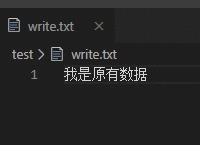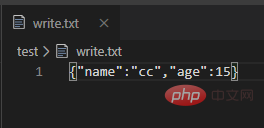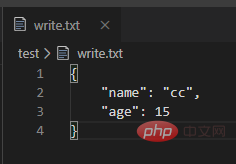Take you to use Node to read and write txt and Excel files

The front-end sometimes needs to process some data (such as the replacement of multi-language file content). We don’t want to do this kind of repetitive, boring and time-wasting work. ctrl C ctrl V's work, it is best to leave this kind of thing to the computer. [Related tutorial recommendations: nodejs video tutorial]
This article simply introduces how the front-end reads Excel or txt through Node The data in the file is then written to the txt method. First, give the content of the file: the test.txt file has only one sentence (I am the content of the txt file); in the test.xlsx file, the details are as shown in the figure:



Read txt file
Without further ado, show me your code:
/** 引入Node的文件模块 */
const fs = require("fs");
/** 获取要读取的文件的路径 */
const path = "./test.txt";
/** 判断该文件是否存在 */
const isExist = fs.existsSync(path);
/** 读取文件的内容 */
const data = isExist ? fs.readFileSync(path, "utf-8") : "";
/** 测试读取 */
console.log("test.txt的内容:", data) // test.txt的内容: 我是txt文件的内容Write txt file
/** 引入Node的文件模块 */
const fs = require("fs");
/** 测试Take you to use Node to read and write txt and Excel files */
fs.writeFile("write.txt", "测试Take you to use Node to read and write txt and Excel files", (err, data) => {
if (err) throw err;
}); Here we do not need to actively create write.txt, the code will automatically determine whether the file exists, and if it does not exist, it will automatically create the file. Note that if the file exists, when calling writeFile (refer to this for complete usage of this method), the original content will be replaced with new content. The operation is as follows:

There is also an append operation, which is to add data on the original basis:
/** 引入Node的文件模块 */
const fs = require("fs");
/** 测试Take you to use Node to read and write txt and Excel files */
fs.appendFile("write.txt", "测试Take you to use Node to read and write txt and Excel files", (err, data) => {
if (err) throw err;
});The operation is as follows:

Tips: What needs to be noted here is that when we write a JS object directly to the file, the result does not meet our expectations:
/** 引入Node的文件模块 */
const fs = require("fs");
const obj = {
name: 'cc',
age: 15
}
/** 测试Take you to use Node to read and write txt and Excel files */
fs.writeFile("write.txt", obj, (err, data) => {
if (err) throw err;
});Run result:

At this time, you can stringify the object through JSON.stringify(), that is:
/** 引入Node的文件模块 */
const fs = require("fs");
const obj = {
name: 'cc',
age: 15
}
/** 测试Take you to use Node to read and write txt and Excel files */
fs.writeFile("write.txt", JSON.stringify(obj), (err, data) => {
if (err) throw err;
});The results are as follows:

In order to make the writing format look better, you can add some parameters to the JSON.stringify() method ( For the use of JSON.stringify() method, please refer to this), for example, add a Tab indentation:
/** 引入Node的文件模块 */
const fs = require("fs");
const obj = {
name: 'cc',
age: 15
}
/** 测试Take you to use Node to read and write txt and Excel files */
fs.writeFile("write.txt", JSON.stringify(obj, null, '\t'), (err, data) => {
if (err) throw err;
});
Read Excel file
/** 引入Node的文件模块 */
const fs = require("fs");
/** 引入Excel文件处理模块(若没安装,安装一下即可) */
const xlsx = require('node-xlsx');
/** 解析excel文档 */
const sheets = xlsx.parse('./test.xlsx');
console.log("sheets data:", sheets)You can see the output results:

The parsed contentsheets is an array, each A sheet takes the form of an object { name: 'xxx', data: [...]} as an element of the array.
The complete look is as follows:
/** sheets的完整内容 */
[{
name: 'Sheet1', /** sheet页名称 */
data: [
['name', 'age'], /** 第一个元素为表头 */
['Tom', 11],
['Bob', 13]
]
}, {
name: 'Sheet2', /** sheet页名称 */
data: [
['animal', 'legs'], /** 第一个元素为表头 */
['cat', 4],
['dog', 4],
['duck', 2]
]
}]Write to Excel file
From the above we know the format of the file after reading Excel , then writing only needs to be constructed according to this format, and then call the function to write~
/** 引入Node的文件模块 */
const fs = require("fs");
/** 引入Excel文件处理模块 */
const xlsx = require('node-xlsx');
/** 构建数据 */
const myData = [{
name: '我的表格1',
data: [
['name', 'age'],
['Tom', 11],
['Bob', 13]
]
}, {
name: '我的表格2',
data: [
['animal', 'legs'],
['cat', 4],
['dog', 4],
['duck', 2]
]
}]
/** 构建数据流 */
const buffer = xlsx.build(myData);
/** 将数据Take you to use Node to read and write txt and Excel fileswrite.xlsx */
fs.writeFile('./write.xlsx', buffer, err => {
if (err) {
throw err;
}
});Similarly, the write.xlsx file will be automatically created if it does not exist. The running results are as follows:

#At this point, we all know how to read and write files. Next, you can do whatever you want, and you can happily do it. Playing with data~
For more node-related knowledge, please visit: nodejs tutorial!
The above is the detailed content of Take you to use Node to read and write txt and Excel files. For more information, please follow other related articles on the PHP Chinese website!

Hot AI Tools

Undresser.AI Undress
AI-powered app for creating realistic nude photos

AI Clothes Remover
Online AI tool for removing clothes from photos.

Undress AI Tool
Undress images for free

Clothoff.io
AI clothes remover

Video Face Swap
Swap faces in any video effortlessly with our completely free AI face swap tool!

Hot Article

Hot Tools

Notepad++7.3.1
Easy-to-use and free code editor

SublimeText3 Chinese version
Chinese version, very easy to use

Zend Studio 13.0.1
Powerful PHP integrated development environment

Dreamweaver CS6
Visual web development tools

SublimeText3 Mac version
God-level code editing software (SublimeText3)

Hot Topics
 Is nodejs a backend framework?
Apr 21, 2024 am 05:09 AM
Is nodejs a backend framework?
Apr 21, 2024 am 05:09 AM
Node.js can be used as a backend framework as it offers features such as high performance, scalability, cross-platform support, rich ecosystem, and ease of development.
 How to connect nodejs to mysql database
Apr 21, 2024 am 06:13 AM
How to connect nodejs to mysql database
Apr 21, 2024 am 06:13 AM
To connect to a MySQL database, you need to follow these steps: Install the mysql2 driver. Use mysql2.createConnection() to create a connection object that contains the host address, port, username, password, and database name. Use connection.query() to perform queries. Finally use connection.end() to end the connection.
 What are the global variables in nodejs
Apr 21, 2024 am 04:54 AM
What are the global variables in nodejs
Apr 21, 2024 am 04:54 AM
The following global variables exist in Node.js: Global object: global Core module: process, console, require Runtime environment variables: __dirname, __filename, __line, __column Constants: undefined, null, NaN, Infinity, -Infinity
 What is the difference between npm and npm.cmd files in the nodejs installation directory?
Apr 21, 2024 am 05:18 AM
What is the difference between npm and npm.cmd files in the nodejs installation directory?
Apr 21, 2024 am 05:18 AM
There are two npm-related files in the Node.js installation directory: npm and npm.cmd. The differences are as follows: different extensions: npm is an executable file, and npm.cmd is a command window shortcut. Windows users: npm.cmd can be used from the command prompt, npm can only be run from the command line. Compatibility: npm.cmd is specific to Windows systems, npm is available cross-platform. Usage recommendations: Windows users use npm.cmd, other operating systems use npm.
 Pi Node Teaching: What is a Pi Node? How to install and set up Pi Node?
Mar 05, 2025 pm 05:57 PM
Pi Node Teaching: What is a Pi Node? How to install and set up Pi Node?
Mar 05, 2025 pm 05:57 PM
Detailed explanation and installation guide for PiNetwork nodes This article will introduce the PiNetwork ecosystem in detail - Pi nodes, a key role in the PiNetwork ecosystem, and provide complete steps for installation and configuration. After the launch of the PiNetwork blockchain test network, Pi nodes have become an important part of many pioneers actively participating in the testing, preparing for the upcoming main network release. If you don’t know PiNetwork yet, please refer to what is Picoin? What is the price for listing? Pi usage, mining and security analysis. What is PiNetwork? The PiNetwork project started in 2019 and owns its exclusive cryptocurrency Pi Coin. The project aims to create a one that everyone can participate
 Is there a big difference between nodejs and java?
Apr 21, 2024 am 06:12 AM
Is there a big difference between nodejs and java?
Apr 21, 2024 am 06:12 AM
The main differences between Node.js and Java are design and features: Event-driven vs. thread-driven: Node.js is event-driven and Java is thread-driven. Single-threaded vs. multi-threaded: Node.js uses a single-threaded event loop, and Java uses a multi-threaded architecture. Runtime environment: Node.js runs on the V8 JavaScript engine, while Java runs on the JVM. Syntax: Node.js uses JavaScript syntax, while Java uses Java syntax. Purpose: Node.js is suitable for I/O-intensive tasks, while Java is suitable for large enterprise applications.
 Is nodejs a back-end development language?
Apr 21, 2024 am 05:09 AM
Is nodejs a back-end development language?
Apr 21, 2024 am 05:09 AM
Yes, Node.js is a backend development language. It is used for back-end development, including handling server-side business logic, managing database connections, and providing APIs.
 Which one to choose between nodejs and java?
Apr 21, 2024 am 04:40 AM
Which one to choose between nodejs and java?
Apr 21, 2024 am 04:40 AM
Node.js and Java each have their pros and cons in web development, and the choice depends on project requirements. Node.js excels in real-time applications, rapid development, and microservices architecture, while Java excels in enterprise-grade support, performance, and security.






